Introduction:
The production of recombinant proteins is essential for the characterization and functional study of Plasmodium falciparum proteins. However, Plasmodium falciparum Recombinant proteins are among the most difficult to express, and when the expression is achieved, recombinant proteins generally misfold leading to inclusion body formation.
Objective:
Obtain and purify four recombinant proteins and use them as antigens to produce polyclonal antibodies. Production efficiency and solubility were evaluated as proteins were expressed in two Escherichia coli strains genetically modified to favour heterologous protein production (BL21-CodonPlus (DE3)-RIL and BL21-pG-KJE8).
Materials and methods:
The four recombinant proteins of P. falciparum correspond to the partial sequences of PfMyoA (Myosin A) and PfGAP50 (slip-associated protein 50) and the complete sequences of PfMTIP (a protein that interacts with the myosin tail). and PfGAP45 (slip-associated protein 45), were produced as glutathione S-transferase fusion proteins, purified and used to immunize mice.

- Parasites
Parasite strains P. falciparum FCR3S1.2 and TM284S2 were cultured according to standard methods with 10% AB+ Rh+ serum added to the buffered medium (RPMI supplemented with Hepes, gentamicin and sodium bicarbonate). Genomic DNA from these parasites was purified using the EasyDNA purification kit (Invitrogen) according to the manufacturer’s protocol.
- Recombinant plasmids
Plasmid constructs for expression of the recombinant proteins GST-DBL1α and GST-CIDR1α of FCR3S1.2var 1PfEMP1, GST-DBL1α and GST-DBL2β of TM284S2var 1PfEMP1 were generated as described previously [18, 19].
- Codon optimization and gene resynthesis
The sequence of the DBL1α domain of FCR3S1.2var 1PfEMP1 was optimized for codon matching in E. coli. Genes were chemically resynthesized (GeneArt, Germany). Resynthesized DBL1α was amplified with oligonucleotide primers (BL-1 5′-ATG GCT ACT TCC GGA GGA, BL-1.1 5′-TTC GAT AAG CAG AAG AAG TAC) and cloned into pGEX4T-1 vector.
- E. coli strain
The BL21-CodonPlus-RIL strain purchased from Stratagene (California, USA) was used for protein expression. This bacterial strain has been engineered to contain a high copy number of arginine U, leucine W, and isoleucine Y tRNA genes for optimal expression of heterologous proteins from organisms with A/T-rich genetic sequences.
- Expression of PfEMP1 domains in BL21-CodonPlus-RIL bacteria
Competent BL21 cells were transformed with recombinant pGEX4T-1 plasmids containing FCR3S1.2 DBL1α, TM284S2 DBL1α or TM284S2 DBL2β as inserts. Transformed bacteria were selected on LB agar plates containing ampicillin (100 µg/ml). A single colony of transformed bacteria was inoculated into 30 ml of LB medium containing ampicillin (100 µg/ml) and chloramphenicol (50 µg/ml) for growth at 37°C overnight. Aliquots of the culture were inoculated into one litre of LB medium containing ampicillin (100 µg/ml).
The cultivation was carried out with a stirring speed of 225 rpm. The pH value and the optical density at A600 of the cultures were systematically controlled. Aliquots (50 ml) of each culture were taken sequentially after the OD A600 reached 0.5 and IPTG (isopropyl-b-D-thiogalactopyranoside) was added to a final concentration of 0.1 mM to induce expression. Expression was carried out for three hours at 37°C and the bacteria were subsequently harvested by centrifugation at 4000 rpm for 15 minutes. Recombinant proteins were purified on glutathione-sepharose (Amersham-Pharmacia, Sweden).

- SDS-PAGE analysis of recombinant proteins
To analyze the recombinant proteins, aliquots of the soluble and insoluble fractions of the expressed proteins from each purification were mixed with an equal volume of SDS-PAGE loading buffer containing β-mercaptoethanol and boiled at 100 °C for 5 min. Denatured proteins were resolved on 10% acrylamide gels containing 1% SDS and visualized by Coomassie brilliant blue solution staining.
- Binding to heparin and blood group A antigen
Recombinant DBL1α purified from FCR3S1.2 expressed with pGEX plasmids containing the wild-type DBL1 sequence or the codon-optimized sequence was further passed through a HiTrap-heparin column (Amersham-Pharmacia Biotech, Sweden). After washing with PBS tween-20 buffer, bound protein was released from the column with 2M NaCl and immediately dialyzed against cold PBS. Aliquots of the eluted proteins were subjected to SDS-PAGE. The binding of recombinant FCR3S1.2 DBL1α to blood group A antigen was studied using a solid phase assay system.
Results:
Protein expression was much more efficient in BL21-CodonPlus, the strain containing tRNAs that are rare in wild-type E. coli, compared to expression in BL21-pG-KJE8. Although BL21-pG-KJE8 overexpresses chaperones, this strain did not minimize inclusion body formation.
Conclusion:
The use of genetically modified E. coli strains was essential to achieve high levels of expression of the four P. falciparum proteins evaluated and improve the solubility of two of them. The approach used here allowed us to obtain and purify four P. falciparum proteins in sufficient quantity to produce polyclonal antibodies in mice and a good quantity of two pure and soluble recombinant proteins for future tests.
Keywords: Escherichia coli.; Plasmodium falciparum; recombinant proteins.

